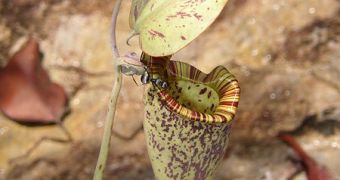These are the most amazing carnivorous plants: the 117 pitcher plant species of the genus Nepenthes, found from Madagascar and southeastern Asia to northeastern Australia. They possess the most spectacular traps, even if considered amongst the least sophisticated functionally, till the publication of a new research in the journal PLoS ONE.
Also called "Monkey cups" as the monkeys have been seen drinking rainwater from these plants, the pitchers are mainly epihytes, that's why they must hunt insects to get the necessary nitrogen.
The leaf continues with a tendril than ends with the pitcher like trap. The trap has a fluid of the plant's own production, which may be watery or syrupy and is used to drown the prey. The lower part of the trap contains glands which absorb nutrients from captured prey.
The upper inside of the trap has a slick waxy coating which impedes the escape of almost any prey. Around the entrance to the trap is a structure called the peristome (the "lip") which is slippery and often quite colorful, attracting prey but offering an unsure footing. Above the peristome there is a lid (the operculum): in many species this keeps rain from diluting the fluid within the pitcher, the underside of which may present nectar glands which attract prey.
The Nepenthes trap can be 50 cm (20 inch) long and 15 cm (6 inch) wide, and the plants usually capture insects, even if larger species has been signaled, like rats or lizards. The fluid inside the pitcher was believed to act just like a digestive juice, but the new French research has revealed to act also on trapping the victims.
High-speed videos made on Nepenthes rafflesiana of Borneo showed that flies attempting to escape the fluid got stuck rapidly, apparently tied by sticky filaments emerging from the juice, resembling elastic mucus fluids. "The elastic consistency of the plant fluid also makes it resemble quicksand. The quicker insects within the fluid move, the more trapped they become", said co-author Yoel Forterre, physicist at the University of Marseille.
"The only chance for insects to escape the fluid would be to move slowly. But once fallen in the pitchers, insects most often panic and exhibit quick movements.", said co-author Laurence Gaume, biologist at the University of Montpellier.
The liquid was effective even when diluted at below 10 % with water, adapting to the abundant rainfall in the plant's habitat, and the juice could act this way in all Nepenthes species.
Further investigation of the liquid could explain the behavior of similarly elastic liquids, like mucus and blood, the crawling of snails "or motion of spermatozoa in the female reproductive tract", Forterre added.
But the researchers are intrigued by the fact that the pitchers harbor whole mini-communities, not affected by the liquid, like mosquitoes and midge larvae eating the debris accumulated in the pitchers and help to a more rapid breakdown of the captured prey. There is also a species of crab spider that can enter and get out of the pitcher at will, even stealing from the plant's victims. "It would be useful to carry out more fieldwork and lab observations to study how insects that live in this fluid manage," said Gaume.

 14 DAY TRIAL //
14 DAY TRIAL //